尼洋河景区游客接待站
01 October 2010
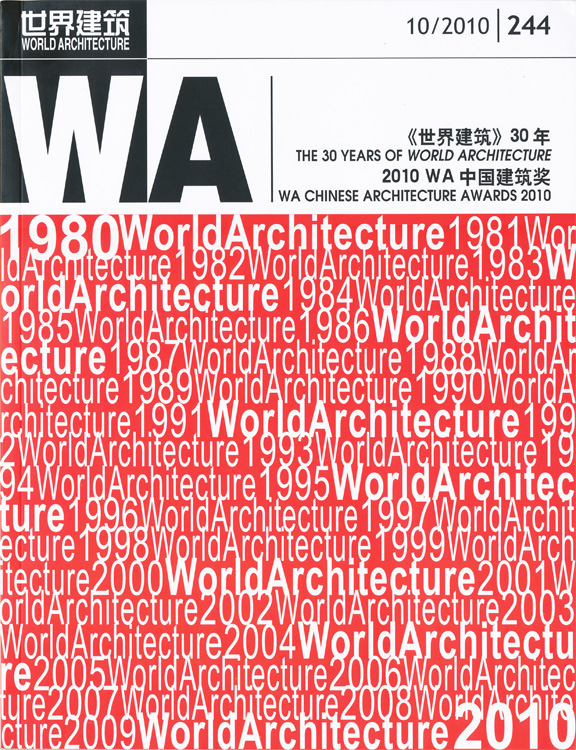

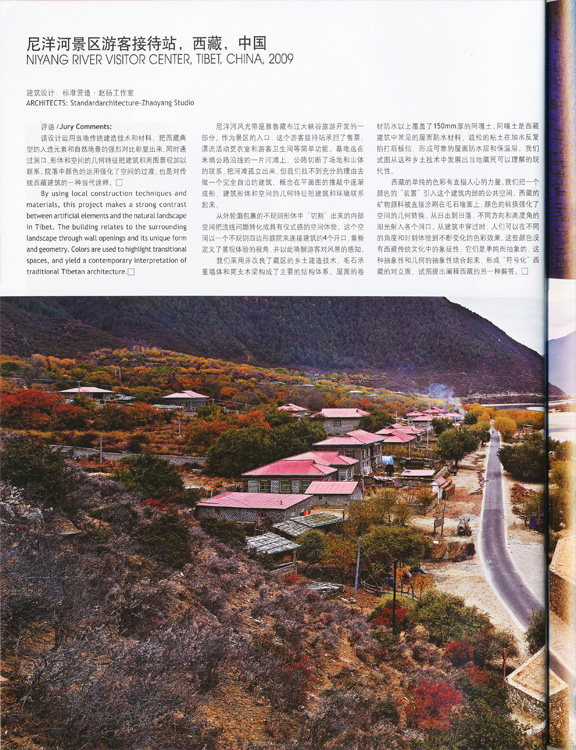
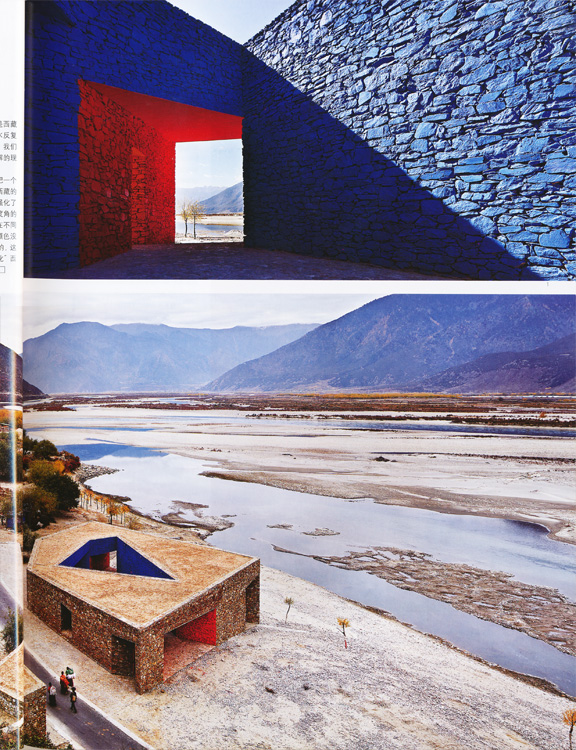
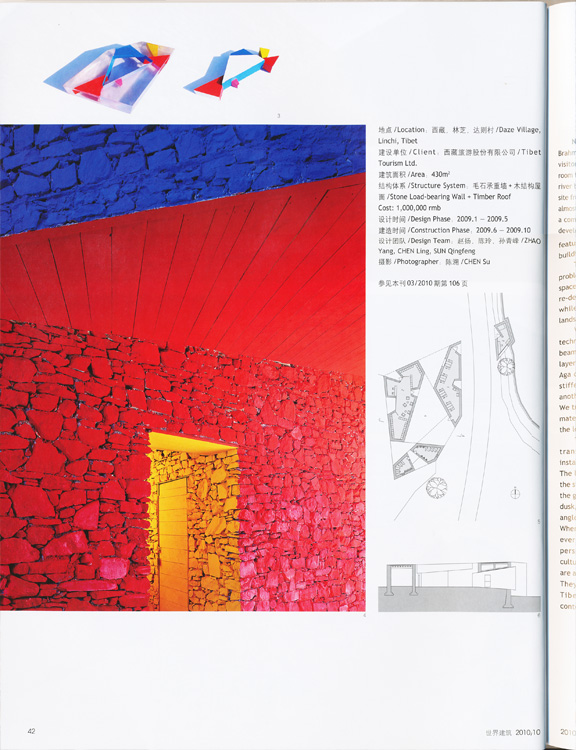
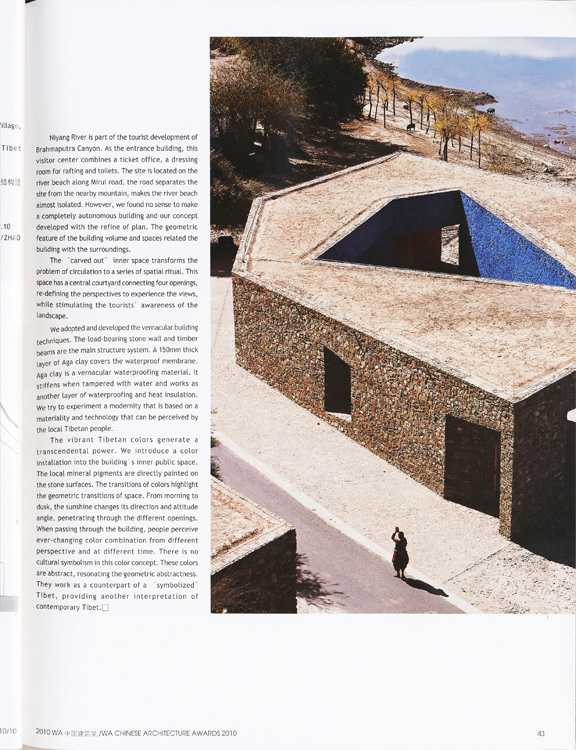
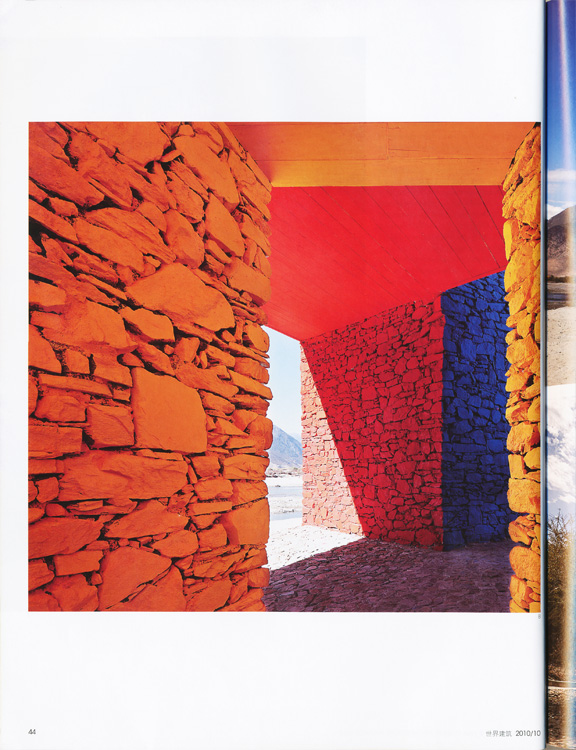
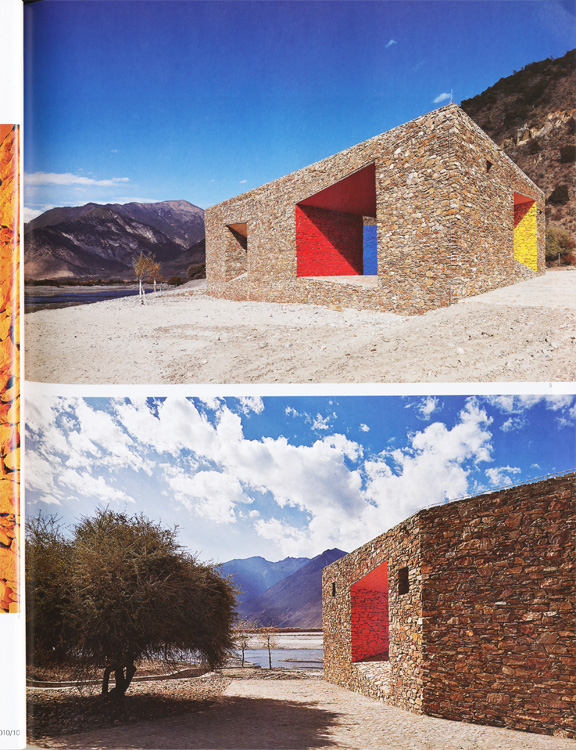
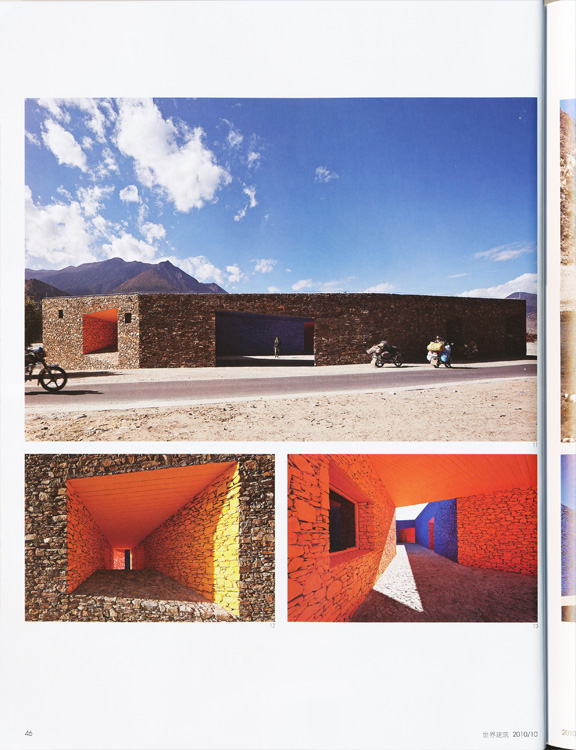
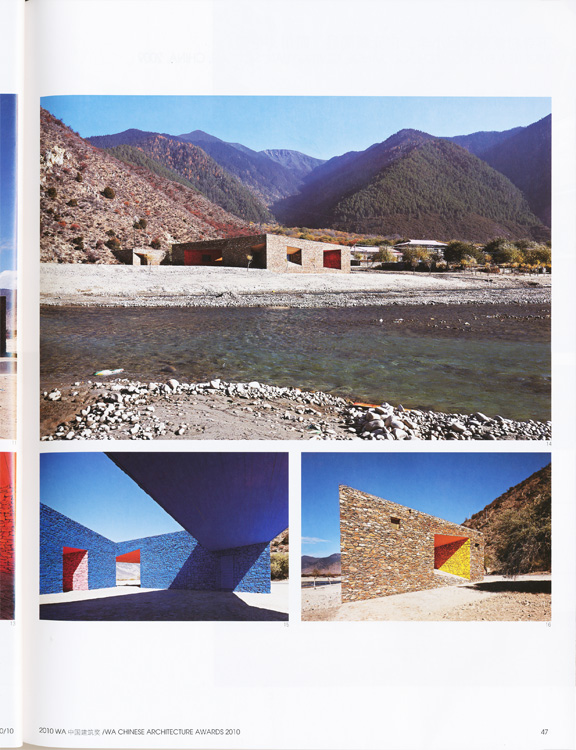
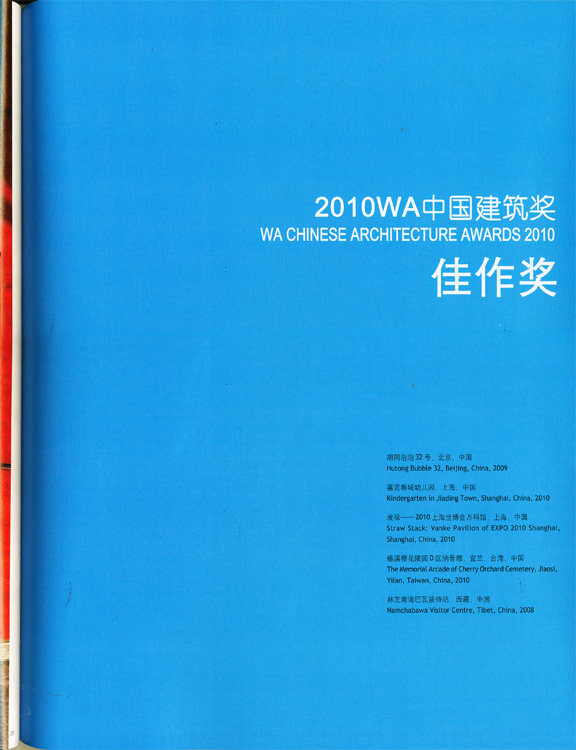
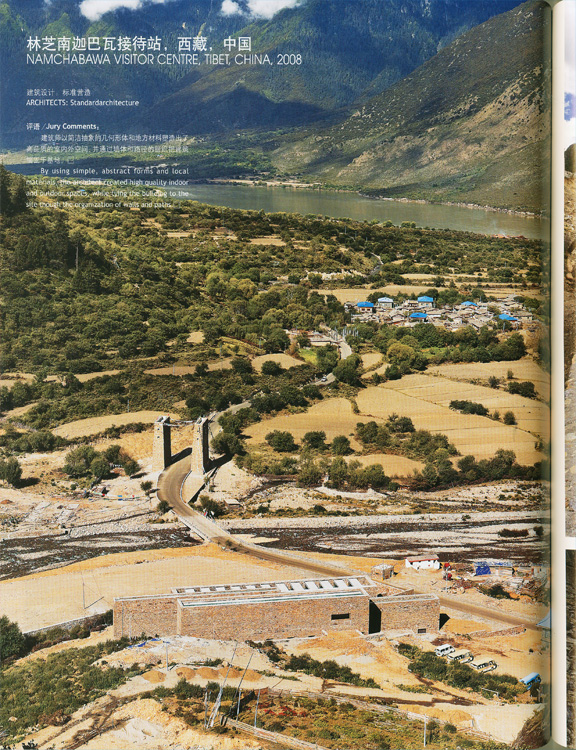
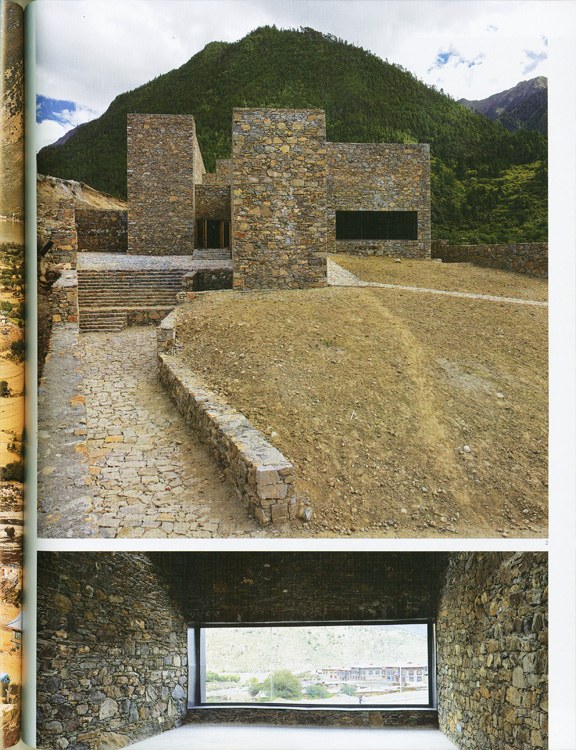
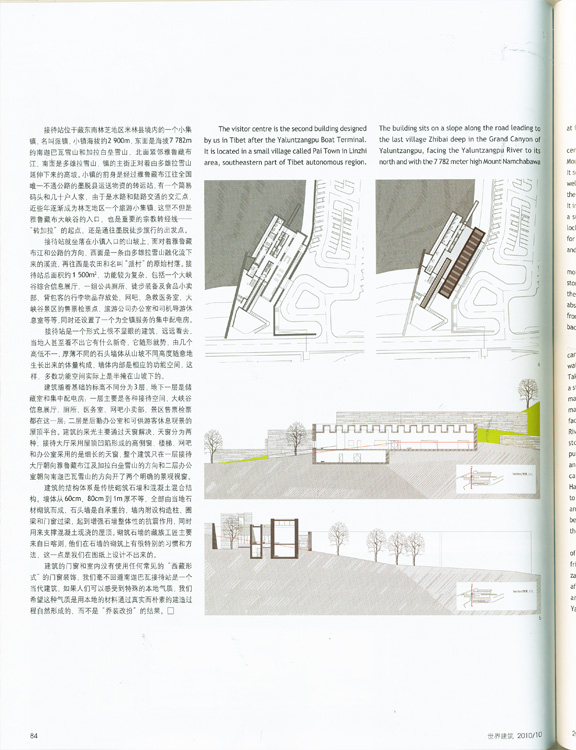


Niyang river visitor center, Tibet, China, 2009
Architects: Standardarchitecture - Zhaoyang Studio
Jury Comments:
By using local construction techniques and materials, this project makes a strong contrast between artificial elements and the natural landscape in Tibet. The building relates to the surrounding landscape through wall openings and its unique form and geometry. Colors are used to highlight transitional spaces, and yield a contemporary interpretation of traditional Tibetan architecture.
Niyang River is part of the tourist development of Brahmaputra Canyon. As the entrance building, this visitor center combines a ticket office, a dressing room for rafting and toilets. The site is located on the river beach along Mirui road, the road separates the site from the nearby mountain, makes the river beach almost isolated. However, we found no sense to make a completely autonomous building and our concept developed with the refine of plan. The geometric feature of the building volume and spaces related the building with the surroundings.
The "carved out" inner space transforms the problem of circulation to a series of spatial ritual. This space has a central courtyard connecting four openings, re-defining the perspectives to experience the views, while stimulating the tourists' awareness of the landscape.
We adopted and developed the vernacular building techniques. The load-bearing stone wall and timber beams are the main structure system. A 150mm thick layer of Aga clay covers the waterproof membrane. Aga clay is a vernacular waterproofing material. It stiffens when tampered with water and works as another layer of waterproofing and heat insulation. We try to experiment a modernity that is based on a materiality and technology that can be perceived by the local Tibetan people.
The vibrant Tibetan colors generate a transcendental power. We introduce a color installation into the building's inner public space. The local mineral pigments are directly painted on the stone surfaces. The transitions of colors highlight the geometric transitions of space. From morning to dusk, the sunshine changes its direction and altitude angle, penetrating through the different openings. When passing through the building, people perceive ever-changing color combination from different perspective and at different time. There is no cultural symbolism in this color concept. These colors are abstract, resonating the geometric abstractness. They work as a counterpart of a "symbolized" Tibet, providing another interpretation of contemporary Tibet.
Location:Daze Village, Linchi, Tibet
client: Tibet Tourism Ltd
Area: 430㎡
structue System: Stone Load-bearing Wall+Timber Roof
Cost: l,000,000 rmb
Design Phase: 2009.1-2009.5
Construction Phase: 2009.6-2009.10
Design Team: ZHAO Yang, CHEN Ling, SUN Qingfeng
Photographer: CHEN Su
Namchabawa visitor centre, Tibet, China, 2008
Architects: Standardardarchitecture
Jury Comments:
By using simple, abstract forms and local materials, the architect created high quality indoor and outdoor spaces, while tying the building to the site though the organization of walls and paths.
The visitor centre is the second building designed by us in Tibet after the Yaluntzangpu Boat Terminal. It is located in a small village called Pai Town in Linzhi area, southeastern part of Tibet autonomous region. The building sits on a slope along the road leading to the last village Zhibai deep in the Grand Canyon of Yaluntzangpu, facing the Yaluntzangpu River to its north and with the 7782 meter high Mount Namchabawa at its background in the east.
The 1500 sqm building serves as a visitor welcome centre providing comprehensive information about Mount Namchabawa and Yaluntzangpu Grand Canyon. It serves also as the "town centre" for the villagers as well as the supply base for the backpack hikers exploring the canyon. Therefore the program is quite complicated. It includes a reception/information hall, public toilets, a supply store, an internet bar, a medical center, locker room for backpackers, meeting rooms, offices for tour guides and drivers, a water reservation tank and a central electrical switch house for the village.
Like a few slices of rock extending out of the mountain, the building is conceived as a series of stone walls set into the slope, with no windows facing the incoming road in the west, almost scale-less, an abstract landscape in the natural landscape. Looking from afar it neither hides itself, nor stands out from its background as a piece of "Tibetan" architecture.
Approaching from a distance on the road, people can not be sure if this is a building or a set of retaining wall or even a "Mani" wall at the foot of the mountain. Taking off their cars, visitors follow a pathway led by a stone retaining wall up the hill, where they find the main entrance to the reception/exhibition hall. The main hall is lit by sky lights and has a view window facing north towards the village and the Yaluntzangpu River. Entering the second layer of the 1-meter-thick stone wall, visitors find the public toilets and the public luggage storage room, going further through another layer of stone wall they find the internet café, medical clinic and the drivers rest space. Halfway they have the choice of taking the "stair way to heaven" up to the second floor for the roof garden and the meeting rooms. The water tank is hidden beneath the stairs and the electric switch room takes the underground space.
After a brief rest, gathering necessary information of the area and other supplies, sending out emails to friends and relatives, visitors are again led by a zig-zag stone path way down the hill into the village, and afterwards, set foot to explore the Mount Namchabawa and disappear into the no-man-forest of the Yaluntzangpu valley for days and weeks.
尼洋河景区游客接待站,西藏,中国
建筑设计:标准营造•赵扬工作室
评语
该设计运用当地传统建造技术和材料,把西藏典型的人造元素和自然地景的强烈对比彰显出来,同时通过洞口、形体和空间的几何特征把建筑和周围景观加以联系。院落中颜色的运用强化了空间的过渡,也是对传统西藏建筑的一种当代诠释。
尼洋河风光带是雅鲁藏布江大峡谷旅游开发的一部分。作为景区的入口,这个游客接待站承担了售票、漂流活动更衣室和游客卫生间等简单功能。基地选在米瑞公路沿线的一片河滩上,公路切断了场地和山体的联系,把河滩孤立出来,但我们找不到充分的理由去做一个完全自治的建筑,概念在平面图的推敲中逐渐成形,建筑形体和空间的几何特征把建筑和环境联系起来。
以外轮廓包裹的不规则形体中“切割”出来的内部空间把流线问题转化成具有仪式感的空间体验。这个空间以一个不规则四边形庭院来连接建筑的4个开口,重新定义了景观体验的视角,并以此唤醒游客对风景的感知。
我们采用并改良了藏区的乡土建造技术,毛石承重墙体和简支木梁构成了主要的结构体系。屋面的卷材防水以上覆盖了150mm厚的阿嘎土。阿嘎土是西藏建筑中常见的屋面防水材料,疏松的粘土在加水反复拍打后板结,形成可靠的屋面防水尾和保温层。我们试图以这种乡土技术中发展出当地藏民可以理解的现代性。
西藏的单纯的色彩有直指人心的力量。我们把一个颜色的“装置”引入这个建筑内部的公共空间。西藏的矿物颜料被直接涂刷在毛石墙面上,颜色的转换强化了空间的几何转换。以日出到日落,不同方向和高度角的阳光射入各个洞口。从建筑中穿过时,人们可以在不同的角度和时刻到不断变化的色彩效果。这些颜色没有西藏建筑文化中的象征性,它们是单纯而抽象的,这种抽象性和几何的抽象性结合起来,形成“符号化”西藏的对立面,试图提出阐释西藏的另一种解答。
地点:西藏,林芝,达则村
建设单位:西藏旅游股份有限公司
建筑面积:430㎡
结构体系:毛石承重墙+木结构屋面
设计时间:2009.1-2009.5
建造时间:2009.6-2009.10
设计团队:赵扬,陈玲,孙青峰
摄影:陈溯
林芝南迦巴瓦接待站,西藏,中国
建筑设计:标准营造
评语
建筑师以简洁抽象的几何形体和地方材料塑造出了高品质的室内外空间,并通过墙体和路径的组织把建筑锚固于基地。
接待站位于藏东南林芝地区米林县境内的一个小集镇,名叫派镇,小镇海拔约2900m,东面是海拔7782m的南迦巴瓦雪山和加拉白垒雪山,北面紧邻雅鲁藏布江,南面是多雄拉雪山,镇的主街正对着由多雄拉雪山延伸下来的高坡。小镇的前身是经过雅鲁藏布江往全国唯一不通公路的墨脱县运送物资的转运站,有—个简易码头和几十户人家,由于是水路和陆路交通的交汇点,近些年逐渐成为林芝地区一个旅游小集镇,这里不但是雅鲁藏布大峡谷的入口,也是重要的宗教转经线——“转加拉”的起点,还是通往墨脱徒步旅行的出发点。
接待站就坐落在小镇入口的山坡上,面对着雅鲁藏布江和公路的方向,西面是一条由多雄拉雪山融化流下来的溪流,再往西是农田和名叫“派村”的原始村落。接待站总面积约1500 m²,功能较为复杂,包括一个大峡谷综合信息展厅、一组公共厕所、徒步装备及食品小卖部、背包客的行李物品存放处、网吧、急救医务室、大峡谷景区的售票检票点、旅游公司办公室和司机导游休息室等等,同时还设置了一个为全镇服务的集中配电房。
接待站是一个形式上很不显眼的建筑,远远看去,当地人甚至看不出它有什么新奇,它随形就势,由几个高低不一、厚薄不同的石头墙体从山坡不同高度随意地生长出来的体量构成,墙体内部是相应的功能空间,这样,多数功能空间实际上是半掩在山坡下的。
建筑随着基础的标高不同分为3层,地下一层是储藏室和集中配电房;一层主要是各种接待空间,大峡谷信息展厅、厕所、医务室、网吧小卖部、景区售票检票都在这一层;二层是后勤办公室和可供游客休息观景的屋顶平台。建筑的采光主要通过天窗解决,天窗分为两种,接待大厅采用屋顶凹陷形成的高侧窗,楼梯、网吧和办公室采用的是细长的天窗,整个建筑只在一层接待大厅朝向雅鲁藏布江及加拉白垒雪山的方向和二层办公室朝向南迦巴瓦雪山的方向开了两个明确的景观视窗。
建筑的结构体系是传统砌筑石墙和混凝土混合结构。墙体从60cm、80cm到lm厚不等,全部由当地石材砌筑而成,石头墙是自承重的,墙内附设构造柱、圈梁和门窗过梁,起到增强石墙整体性的抗震作用,同时用来支撑混凝土现浇的屋顶。砌筑石墙的藏族工匠主要来自日喀则,他们在石墙的砌筑上有很特别的习惯和方法,这一点是我们在图纸上设计不出来的。
建筑的门窗和室内没有使用任何常见的“西藏形式”的门窗装饰,我们毫不回避南迦巴瓦接待站是一个当代建筑,如果人们可以感受到特殊的本地气质,我们希望这种气质是用本地的材料通过真实而朴素的建造过程自然形成的,而不是“乔装改扮”的结果。